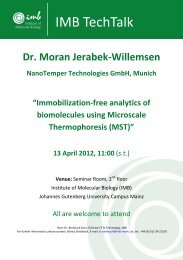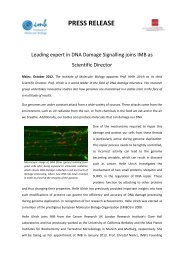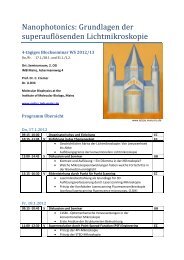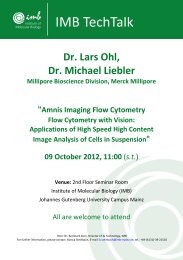Low-resolution PDF - IMB
Low-resolution PDF - IMB
Low-resolution PDF - IMB
You also want an ePaper? Increase the reach of your titles
YUMPU automatically turns print PDFs into web optimized ePapers that Google loves.
Epigenetic regulation of transcription in development and disease<br />
18 “We study the transcriptional<br />
differences between<br />
embryonic endoderm and<br />
adult intestinal stem cells.”<br />
Natalia<br />
Soshnikova<br />
Education<br />
1998 Diploma with honour in Molecular Biology,<br />
Novosibirsk State University<br />
2004 PhD in Molecular Biology, Humboldt University, Berlin<br />
Positions held<br />
2004 - 2011 Postdoctoral Researcher,<br />
Department of Zoology, University of Geneva<br />
From 2012<br />
Group Members<br />
Group Leader, Institute of Molecular Biology (<strong>IMB</strong>),<br />
Mainz<br />
Valerio del Vescovo / Postdoc (Marie Curie Fellowship); since 12/2012<br />
Stefanie Grimm / Research Technician; since 01/2012<br />
Elif Güney / Summer student (Erasmus); 06/2012-09/2012<br />
Sabina Jakob / Student assistant; 06/2012-10/2012<br />
Juri Kazakevych / PhD student; since 09/2012<br />
Julia Koehn / PhD student; 01/2012-05/2012<br />
Christina Krienke / Diploma student; since 04/2012<br />
Eduarda Mazzagao Guerreiro / MSc student (Erasmus); since 09/2012<br />
Research Overview<br />
We are interested in the regulatory mechanisms underlying<br />
vertebrate pattern formation during embryogenesis and tissue<br />
homeostasis in adults. Our current focus is on the endodermal stem<br />
cells of the small intestine, and their mechanisms of maintenance,<br />
differentiation and alteration during the life of an animal. We initiated<br />
an ambitious programme aimed at dissecting these various aspects<br />
of endodermal stem cell biology using both mouse genetics and<br />
functional genomics, including ChIP-, MBD- and RNA-sequencing<br />
technologies. This combination of technological approaches provides<br />
us with a unique opportunity to solve questions regarding the relationship<br />
between chromatin structure and gene regulation; questions that<br />
have become increasingly important over the last few years.<br />
Research Highlights<br />
Molecular characterization of mouse endodermal stem cells<br />
Stem cells are defined by two characteristics; the ability to selfrenew<br />
and the capacity to give rise to one or more differentiated<br />
cell types. Small intestine epithelium homeostasis requires rapid and<br />
continuous regeneration and differentiation of specific cell types from<br />
precursor cells referred to as intestinal stem cells (ISCs). The generation<br />
of specific cell types from the ISCs is dictated by the combinatorial<br />
actions of diverse signals that regulate the expression of transcription<br />
factors and impose developmental restrictions on progenitor cells. In<br />
the adult small intestinal epithelium, differentiated progenitor cells of<br />
enterocytic, goblet and enteroendocrine lineages reside within villi,<br />
whereas proliferating stem cells are found within the intervilli/ crypt<br />
compartment. In contrast, the embryonic intestine appears as a primitive<br />
tube of polarized epithelium with cytologically identical endodermal<br />
cells until at least E14.5. At this time point a drastic remodelling<br />
process leads to villi formation. Little is known about the molecular<br />
changes that occur in the intestinal epithelium during embryogenesis<br />
before villus emergence begins. During the past year we have been<br />
particularly active in establishing specific technologies, including isolation<br />
of endodermal stem cells by Fluorescence Activated Cell Sorting,<br />
RNA-sequencing, MBD-sequencing and ChIP-sequencing, using small










